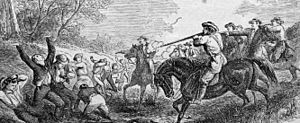Marais des Cygnes massacre facts for kids
The Marais des Cygnes massacre was a sad and violent event that happened on May 19, 1858. It took place near the town of Trading Post, Kansas. This event was the last major violent moment in a period known as Bleeding Kansas. During this time, people fought over whether Kansas would be a free state or a slave state.
A group of pro-slavery fighters, called Border Ruffians, were led by Charles Hamilton. They stopped in the small village of Trading Post in Lynn County, Kansas. Hamilton had been forced off his land in Lynn County by people who wanted Kansas to be a free state. He came back to get revenge.
The group captured eleven free-state men. Hamilton had a strong dislike for all of them. The captives were marched into a nearby ravine. There, the Missourians started shooting at them. This story became very famous across the United States. Newspapers in the East, like The New York Times, wrote about it. Groups against slavery called the victims martyrs, meaning they died for a cause. In 1974, the place where the massacre happened became a National Historic Landmark.
Why the Massacre Happened
In 1854, a law called the Kansas–Nebraska Act was passed. This law allowed settlers in the Kansas Territory to decide if Kansas would be a slave state or a free state. This idea was called popular sovereignty. It meant people would vote to choose.
This law caused many people to move to Kansas. Activists from both sides, those for and against slavery, rushed into Kansas. They wanted to influence the vote. This led to a lot of violence that continued even into the American Civil War.
In Lynn County, problems between free-state and pro-slavery settlers started around 1856. A large group of pro-slavery Southerners came through the area. They destroyed property and captured free-state settlers. One person who escaped was James Montgomery. He became a leader of the free-state settlers in the area. His group was known as the Jayhawkers.
The two groups had many fights. In 1857, James H. Lane put together a group of free-state men. They bothered the pro-slavery forces in Kansas and western Missouri. When Lane's group broke up, James Montgomery took over. He told the pro-slavery leaders to leave the county. Many did leave and went back to Missouri. Charles A. Hamilton was one of them. He left Kansas feeling very angry. Hamilton held a meeting in Papinville, Missouri. He gathered men to invade Kansas. They decided they would get rid of the free-state settlers in Lynn County.
The Horrible Event
Hamilton's group included the exiles and about 17 other Missourians. They rode back into Kansas. They stopped at the village store. With their guns ready, they disarmed the customers and tied their hands. Hamilton took a list from his pocket and read names. One by one, the men on the list were taken from their homes or fields. The village blacksmith fought back with a shotgun and was not captured.
The group captured eleven men. They led them to a small valley that went into the Marais des Cygnes River. The men were lined up in the valley as if they were facing a firing squad. One Missourian lowered his gun. He said he would "have nothing to do with such a piece of business as this." Hamilton then gave the order to fire. The eleven men fell to the ground. Five of the men were killed. Five others were badly wounded. One man escaped unharmed by pretending to be dead.
Sarah Read, the wife of Reverend Samuel Read (one of the captured men), quickly followed Hamilton's men on foot. She found the victims and helped those who were still alive. News of the massacre spread fast. Free-staters rushed to the village to help the wounded and bury the dead. Montgomery's Jayhawkers quickly started looking for the gang but could not find them. Sarah Read searched all night for her husband. He had crawled away after being shot. She found him the next morning, still alive. He was known as "Preacher Read" and he survived the massacre.
What Happened Next
This terrible event got a lot of attention in the North. The murders were shown as an example of planned killing by Missourians and Southerners. The details of the murders were in every newspaper. People read about it in almost every home.
John Brown, a famous abolitionist, came to the village in late June. In 1856, Brown had led his own massacre. It was called the Pottawatomie massacre. In that event, he killed five pro-slavery men and boys. Near Trading Post, he built a two-story log blockhouse with a spring inside for water. The blacksmith, Eli Snider, owned the land. He later sold it to Charles C. Hadsall, who was a friend of Brown's. Brown and his men stayed in the fort until the end of summer. Then they left it for Hadsall to keep guarded.
Charles Hamilton was never captured. During the Civil War, he became a Colonel in the Confederate Army of Northern Virginia. One man, Charles Matlock, was arrested for the crime but he later escaped. Only one person was brought to justice. William Griffith was arrested in 1863. He was tried for murder and on October 30, 1863, he was hung.
Images for kids


